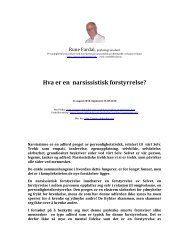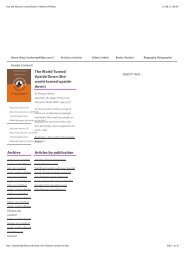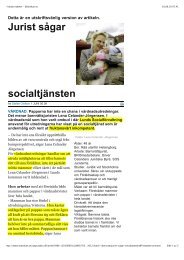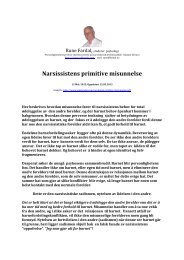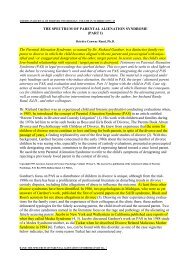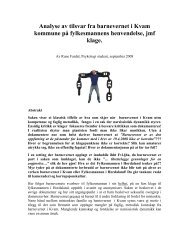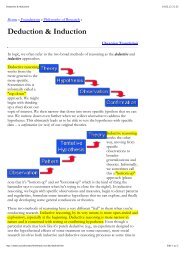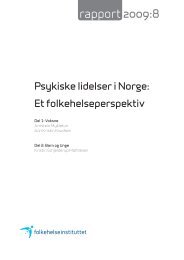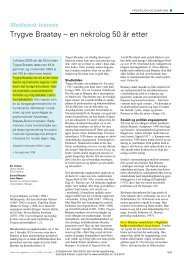The origins of narcissism and narcissistic personality disorder a
The origins of narcissism and narcissistic personality disorder a
The origins of narcissism and narcissistic personality disorder a
You also want an ePaper? Increase the reach of your titles
YUMPU automatically turns print PDFs into web optimized ePapers that Google loves.
90 JOHN S. AUERBACH<br />
omnipotence <strong>and</strong> come to realize instead that independent selfhood<br />
requires, <strong>and</strong> is limited by, recognition by other independent selves.<br />
This recognition by independent others is precarious because other<br />
persons, ins<strong>of</strong>ar as they are truly independent selves, can always<br />
choose not to bestow recognition but to withhold it-to be ab<strong>and</strong>oning,<br />
critical, or rejecting. Thus, to discover one’s autonomy is also to discover<br />
one’s dependence <strong>and</strong> limitation.<br />
Independent selfhood <strong>and</strong> the human capacity for reflexive selfawareness<br />
arise, therefore, from the intepersonal matrix, <strong>and</strong> are constituted<br />
only on the basis <strong>of</strong> mutual self-recognition (Benjamin, 1990;<br />
Buber, 1923/1970; Habermas, 1968/1971; Kirshner, 1991; Winnicott,<br />
1971/1982). On the other h<strong>and</strong>, because mutual self-recognition necessarily<br />
involves dependence <strong>and</strong> limitation, there is always the temptation<br />
to retreat from intersubjectivity to <strong>narcissism</strong>. One may either<br />
deny the other by asserting a gr<strong>and</strong>iose, illusory self-sufficiency or<br />
deny the self through merger with the totality (Andreas-Salome, 19211<br />
1962; Bach, 1985; Balint, 1959; Grunberger, 1971/1979; Rothstein,<br />
1984). Each <strong>of</strong> these <strong>narcissistic</strong> strategies, either shameless gr<strong>and</strong>iosity<br />
or shame-ridden timidity, indicates a failure in the regulation <strong>of</strong> reflexive<br />
self-awareness (Bach, 1985; Broucek, 1982; Kinston, 1983,<br />
1987).<br />
Recognizing the dangers <strong>of</strong> illusory, <strong>narcissistic</strong> responses to ineradicable<br />
human dilemmas, Benjamin (1990, p. 40) writes, ”From the<br />
st<strong>and</strong>point <strong>of</strong> intersubjective theory, the ideal resolution <strong>of</strong> the paradox<br />
<strong>of</strong> recognition is for it to continue as a constant tension between recognizing<br />
the other <strong>and</strong> asserting the self.” This is a resolution based<br />
on an awareness <strong>of</strong> the tragic <strong>and</strong> ironic aspects <strong>of</strong> human existence<br />
<strong>and</strong> <strong>of</strong> the tensions that necessarily emerge in a dialogue between two<br />
independent perspectives. Because <strong>of</strong> the human need for <strong>narcissistic</strong><br />
illusions, whether <strong>of</strong> omnipotence or <strong>of</strong> tensionless merger, it is foolish,<br />
if not impossible, to eliminate such fantasies, But if there is an antidote<br />
to the pervasiveness <strong>of</strong> human <strong>narcissism</strong>, a real solution to the dilemmas<br />
<strong>of</strong> human weakness <strong>and</strong> frailty, it is in the continuing dialogue<br />
<strong>of</strong> self <strong>and</strong> other.<br />
Summary<br />
Freud was <strong>of</strong> at least two minds regarding early infant development.<br />
His most well-known theory, found largely in his later writings, is that




